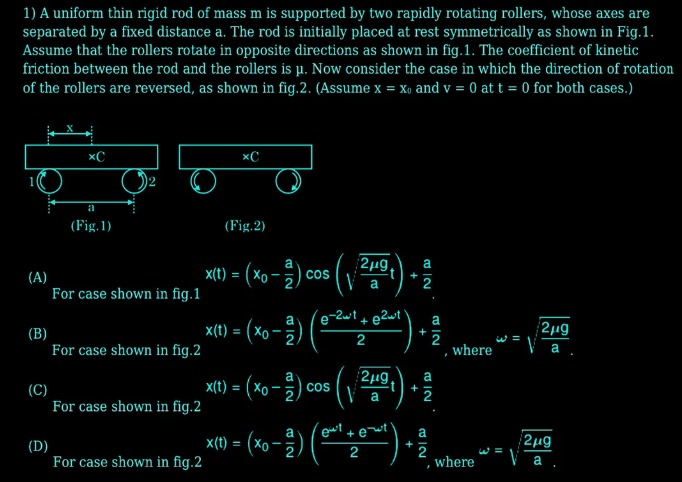Question
Question: A uniform thin rigid rod of mass m is supported by two rapidly rotating rollers, whose axes are sepa...
A uniform thin rigid rod of mass m is supported by two rapidly rotating rollers, whose axes are separated by a fixed distance a. The rod is initially placed at rest symmetrically as shown in Fig.1. Assume that the rollers rotate in opposite directions as shown in fig. 1. The coefficient of kinetic friction between the rod and the rollers is µ. Now consider the case in which the direction of rotation of the rollers are reversed, as shown in fig.2. (Assume x = x₀ and v = 0 at t = 0 for both cases.)

x(t)=(x0−2a)cos(a2μgt)+2a For case shown in fig.1
x(t)=(x0−2a)(2e−2ωt+e2ωt)+2a, where ω=a2μg. For case shown in fig.2
x(t)=(x0−2a)cos(a2μgt)+2a For case shown in fig.2
x(t)=(x0−2a)(2eωt+e−ωt)+2a, where ω=a2μg. For case shown in fig.2
- Fig.1: Option (A)
- Fig.2: Option (D)
Solution
Solution Explanation:
-
For Fig.1:
- When the rollers rotate in opposite directions, the frictional forces produce a restoring force on the rod. This leads to simple harmonic motion about the equilibrium point x=2a.
- The equation of motion becomes: x¨=−a2μg(x−2a) with solution x(t)=(x0−2a)cos(a2μgt)+2a.
- This corresponds to Option (A).
-
For Fig.2:
- When the rollers reverse their direction (rotating in the same direction), the frictional forces now act as a destabilizing force. This produces an “inverted” harmonic oscillator equation: x¨=+a2μg(x−2a)
- The solution with initial conditions x=x0 and v=0 is: x(t)=(x0−2a)cosh(a2μgt)+2a.
- This is equivalent to Option (D), since cosh(a2μgt)=2ea2μgt+e−a2μgt.
